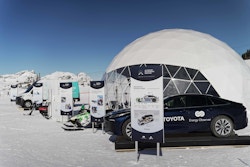Electric and hydrogen mobility challenges in the mountains
From the 4th to the 24th of February 2023, Energy Observer Foundation's exhibition village was set "On top of positive energies" in Avoriaz. An opportunity to assess how electric and hydrogen mobility can contribute to limiting the carbon footprint of a day of skiing.

We have lost count of the number of snow guns vandalized since the beginning of this winter. For some, skiing is not compatible with the fight against global warming. Whether right or wrong, as is often the case, the answer is not that simple. For many mountain professionals, activists, unfortunately, hold the wrong target.
Let's remember that more than 50% of the carbon footprint of a day of skiing - nearly 50 kgCO2eq per person - is related to transportation to get to the resort (1). The ski area represents only 3% of global emissions.

The carbon footprint of day of skiing
Hence the urgency to find more sustainable mobility solutions. Electric and why not hydrogen solutions? But here again, things are not so simple. Mountain conditions (low temperatures, lower air pressure) represent additional challenges to overcome. Take electric cars: like other cars, they are victims of additional consumption (ventilation, lighting, over-consumption due to snow tires, loss of efficiency of regenerative braking, etc.). In addition, their batteries do not like the cold, nor does it produce heat. So for battery heating, as for the electric heating of the passenger compartment, it is necessary to consume part of its energy. That can result in up to 30% less range, which is more than for hydrogen cars, which have the advantage of being able to use the heat produced naturally by their fuel cells.
Less pressure at high altitude
In the mountains, on the other hand, fuel cells face a difficulty that does not affect batteries: the drop in air pressure. Fuel cells rely on the air's oxygen to produce electricity from hydrogen. But in the mountains, there is less oxygen than at the seaside. Thus, hydrogen-powered cars can see their overall performance reduced by 10% or more at altitude unless the speed of the associated compressor increases to bring in more air and boost the compression ratio. All of this is at the expense of the electrical consumption of the compressor and, therefore, its efficiency.
For example, in the city, the consumption of a hydrogen car is about 1 to 1.5 kg of hydrogen per 100 km driven. A few months ago, the French driver Adrien Tambay achieved an endurance record for driving on ice at the wheel of the Hyundai Nexo. With a consumption of 3.1 kg of hydrogen for 100 km! To ensure the performance of vehicles intended to be driven permanently in the mountains, such as snow groomers, experts must consider the reexamination of specifications.
One solution is to develop fuel cells capable of operating at lower pressures, for example.
Hydrogen vehicles less affected by cold weather
Driving in the mountains with an electric or hydrogen car also requires daily adaptations. Since it is not advisable to charge a battery quickly and to 100% in cold weather to preserve its life span, it will be necessary to favor slow recharging at home. That is a new regulation for the mountain habitat, which is already very constrained. When restarting, however, it is difficult to counteract the slowing down of the circulation of ions due to the cold without preheating the battery. The result is poorer performance.
Fuel cells, on the other hand, are less affected by the cold. However, when switching off the ignition, one must be careful and ensure that the fuel cell is sufficiently dried out and drained. That prevents water - produced by the fuel cell itself - from accumulating in the system or forming an ice plug in the exhaust. Once frozen, this water could block the gas flow or cause microcracks that would damage the fuel cell. When restarting, the fuel cell must be heated gently, as with a combustion engine.
The first experiments have been launched, such as snow groomers and hydrogen buses in Alpe d'Huez, Les 2 Alpes, and Grandes Rousses. That is a way to contribute to the carbon neutrality objectives set by Domaines skiables de France for 2037, in particular by developing low-carbon public transport solutions.
But behind the deployment of hydrogen vehicles, there is also a whole economy to rethink. The production of carbon-free hydrogen in the mountains from the water in dams only appears to be a solution if the project goes beyond the ski areas and extends to entire territories.
The vehicle, whether electric or hydrogen, is the tree that hides the forest: if it makes it possible to respond to the urgent need to reduce direct emissions linked to transport to the station, the development of electric and hydrogen recharging stations, the production of hydrogen and low-carbon public transport and energy savings are just as much part of the equation.
(1) Study conducted by the National Association of Mountain Resort Mayors (ANMSM) and the French Environment and Energy Management Agency (Ademe)





